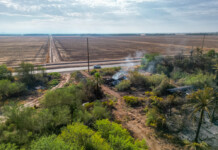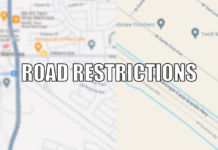Maricopans jumped to the front of the line in service when Cox Communications began offering a full complement of internet, TV and streaming, phone and smart-home services to city neighborhoods this month.
Joshua Johnson, a technical manager with Cox, said the quality of service and the level of technology coming to Maricopa is the best the company has to offer — anywhere.
“It will actually be a little better,” Johnson said of Maricopa’s service compared to that offered in Phoenix. “This will be state-of-the-art. This is the nicest system we’re building right now anywhere in America.”
Those words carry a good deal of weight when you consider Cox is the country’s third-largest cable and internet provider and serves households in 20 states.
The service being offered to Maricopans is fifth- generation fiber to the home. The network is fully passive, meaning it won’t require any electricity to power the lines. Most older systems require a tiny bit of electricity. Instead of copper wires, the fiber consists of hair-like strands of glass covered in a rubber-like material. The lines will consist of 288 of those glass hairs. One hair is powerful enough to supply service to 6,000 homes.
“We’ll be able to comfortably offer Maricopa residents service and with our existing lines; we’ll be in a prime position to grow with the city,” Johnson said.
“The fiber allows us to offer equal upload and download speeds,” Johnson said. “Most of the time, when you see commercials, they only talk about download speeds. That’s how fast the information is getting to the user. A lot of times the upload speed is significantly slower than the download speed. With our fiber, download and upload speeds match.”
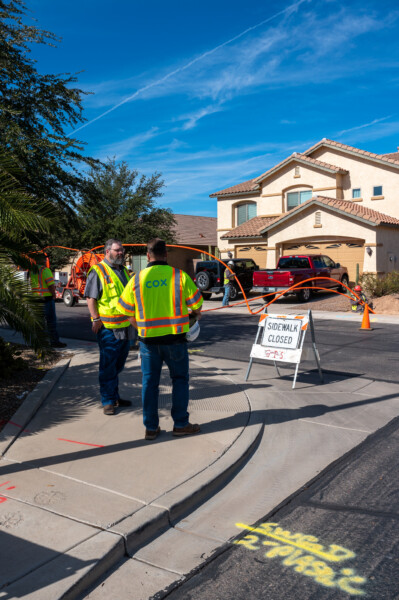
Cox started installing service lines in November in Cobblestone Farms. Soon, service will be added to Rancho El Dorado, The Villages at Rancho El Dorado, Maricopa Meadows, Alterra North and South, Desert Cedars, Santa Rosa and Palo Brea.
The road to Maricopa
Before service gets to your home, it’s broadcast from what Johnson referred to as critical facilities.
“We have several critical facilities around the Phoenix area, and they’re all linked in various different ways. One of those critical facilities is in Casa Grande,” Johnson said.
That facility — and improving technology — opened the door for Cox to enter the market in Maricopa. With the other facilities in the area, there were finally enough backups to offer a stable service in the city, Johnson explained.
“We were in the process of building up to Stanfield (from Casa Grande) and that allowed us to catapult and start to look at how we can bring redundancy into Maricopa City,” Johnson said.
Johnson further explained it’s not just enough to have a single line feeding a city the size of Maricopa; you need multiple sources. In the off chance there’s a catastrophic event that shuts one line, there’s a backup.
“Building Stanfield gave us that opportunity to make our way far enough west to have a viable option to come up with a secondary route and keep Maricopa protected — and have a failsafe,” he said.
An undertaking
Cox’s considerable commitment to Maricopa started 11 months ago and will continue for the foreseeable future.
The permitting process with Maricopa began in January. As of November, Cox had permits allowing immediate installations in nine neighborhoods. While signups are beginning this month, the full implementation of service for the entire city isn’t likely to be complete for two years.
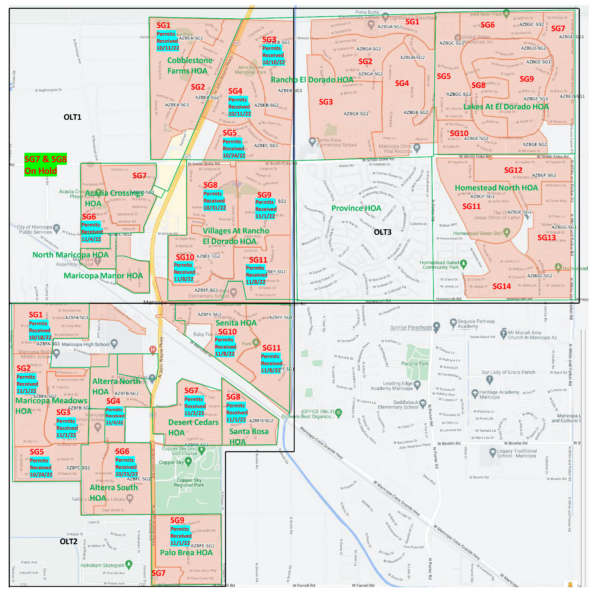
The Maricopa project will provide 22,000 homes with the best service Cox has to offer. Todd Niesen, a construction and planning director with Cox, said it’s a monumental buildout.
In most cases, when a neighborhood is being built out, the wet utilities — water and sewer — are installed. Then after power is brought in, communication companies like Cox are given the chance to lay their lines in the already-open trenches, like they are currently doing in the Valley.
“We’re taking advantage of that and taking the opportunity to put our conduits into the ground,” Niesen said.
But as Johnson explained, the project in Maricopa is different. Most of the homes are pre-existing and it’s what they refer to as an “overbuild,” meaning there are no existing trenches.
“It’s the biggest (overbuild) project we’ve done probably in Arizona,” Johnson said. “It’s at least the biggest we’ve done in my 10 years with Cox.”
There are still many permits left to secure from the city, so construction of the fiber lines is not yet 100%, but the manpower needed to get the project over the finish line is considerable.
At the peak, there will be 20 drill crews consisting of 5-7 workers and pothole crews, which will fill in the holes left from the drilling.
“There will probably be one support crew for every three drill crews,” Niesen said. “There could be anywhere from 27-30 crews out there on any given day.”
But not all those crews will be drilling.
Each phase of the installation will require different crews that specialize in a different aspect of the work being performed, which include drilling crews, crews that pull fiber and those who handle splicing and testing.
“I think 30 is a reasonable number,” Niesen said. “But there are also going to be other crews out there doing non-invasive work. They’re going to be handling the technical side of it.”
Minimal impacts
Make no mistake, you will see Cox installation teams laying fiber in your neighborhood, but don’t expect it to be a deluge. Johnson said it will be done in a non-intrusive manner.
“We’re not going to run eight crews in one neighborhood and make it where the people who live there can’t function,” Johnson said. “We’re going to spread it out as much as possible. We may have one crew in the north side of a community and another in the south side.
“It’s very rare that traffic is ever stopped in both ways while we’re installing the lines.”
Cox officials held an open house in November with the heads of homeowners associations to discuss service and installation plans, and to open a line of communication to alert residents when crews will be in their area.
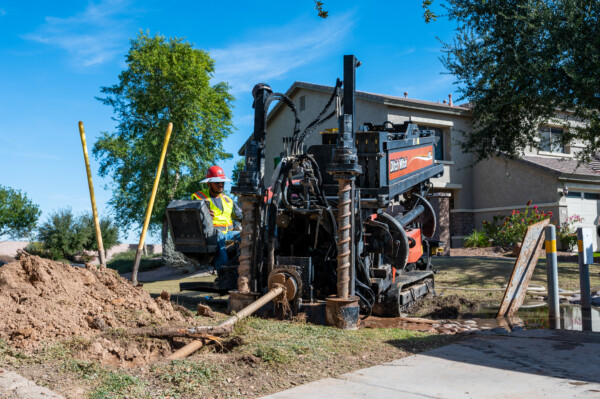
The biggest inconvenience might come when a crew has to move equipment from one side of the street to another.
“We’ve built hundreds of thousands of feet in communities like this and we haven’t had to close any streets for longer than the time it takes to move the equipment,” Niesen said. “That’s just five minutes.”
As for the trenches, there will be a few, but Cox employs side-drilling technology that will cut down on the digging in the right-of-way areas.
“They’re using directional drills,” Johnson said. “The holes will be minimal. We’re going to be as surgical as possible. It’ll be a little noisy, but it will pass quickly. We’re using the most up-to-date technology.”
When a homeowner signs up for service, a ditch will have to be dug between the service line and home so the two can be connected.
New neighbors
The reception from Maricopa has been positive, according to Johnson.
“The city has been wonderful,” he said. “We’ve formed a good relationship with them while working through the process. Anytime you go into a new place, they’re going to have different ways they want things done in how we get permits. They’ve been fantastic to work with. They’ve bent over backwards to make this a good process for us and for the citizens.”
Johnson said residents have been happy to see Cox come into the city.
“We’ve had positive responses in all the communities. People have been very excited to see us there.”
But there’s a lot of work to do, and Johnson acknowledges the biggest challenges are ahead.
“It’s a massive project.
Cox Residential Services | Official Site 1-800-234-3993
This content was first published in the December edition of InMaricopa magazine.

![Cox installation crews will be soon coming to a neighborhood near you to install high-speed internet fiber. The buildout will encompass the entire city and is expected to take two years. [Bryan Mordt]](https://www.inmaricopa.com/wp-content/uploads/2022/11/BCM_1386-2-scaled.jpg)
